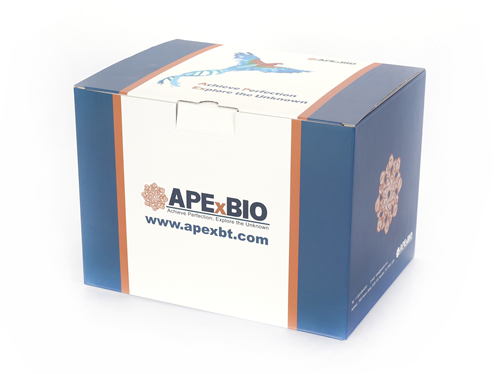- Home
- Signaling Pathways
- Microbiology & Virology
- Antibiotic
- (+)-Aphidicolin
- Home
- Lab Reagents
- Antibiotics
- (+)-Aphidicolin
(+)-Aphidicolin
Aphidicolin, a tetracyclic diterpenoid, is an antibiotic with novel structure produced by the mold Cephalosporium aphidicola. Aphidicolin is an inhibitor of DNA polymerase-α [1].
DNA polymerase-α is an enzyme complex involved in initiation of DNA replication and during synthesis of Okazaki fragments on the lagging strand. The DNA polymerase-α complex consists of 4 subunits: POLA1, POLA2, PRIM1, and PRIM2. POLA1 is the catalytic subunit. POLA2 is the regulatory subunit. PRIM1 and PRIM2 are the small and the large primase subunits [2].
Aphidicolin selectively inhibited the activity of DNA polymerase-α without activity for DNA polymerase-β and mitochondrial DNA polymerase. Aphidicolin prevented cell division in sea urchin embryos [1]. Aphidicolin was a potent inhibitor of cellular deoxyribonucleic acid synthesis. Aphidicolin strongly inhibited the growth of herpes simplex virus both in tissue culture and in the rabbit eye. Aphidicolin was active against iododeoxyuridine-resistant herpes virus [3]. Aphidicolin showed antiviral activity and inhibited the incorporation of thymidine into DNA of cultured human embryonic lung cells. Aphidicolin (15 μg/ml) reduced the activity of crude and partially purified DNA polymerases from the cytosol [4].
References:
[1] Ikegami S, TAGUCHI T, OHASHI M, et al. Aphidicolin prevents mitotic cell division by interfering with the activity of DNA polymerase-α[J]. Nature, 1978, 275(5679): 458-460.
[2] Lehman I R, Kaguni L S, Krause K H, et al. DNA polymerase alpha[J]. J. Biol. Chem, 1989, 264.
[3] Bucknall R A, Moores H, Simms R, et al. Antiviral effects of aphidicolin, a new antibiotic produced by Cephalosporium aphidicola[J]. Antimicrobial agents and chemotherapy, 1973, 4(3): 294-298.
[4] Ohashi M, Taguchi T, Ikegami S. Aphidicolin: a specific inhibitor of DNA polymerases in the cytosol of rat liver[J]. Biochemical and biophysical research communications, 1978, 82(4): 1084-1090.
| Physical Appearance | A white to off- |
| Storage | Store at -20°C |
| M.Wt | 338.48 |
| Cas No. | 38966-21-1 |
| Formula | C20H34O4 |
| Solubility | ≥33.33 mg/mL in DMSO; insoluble in EtOH; insoluble in H2O |
| Chemical Name | (3R,4R,4aR,6aS,8R,9R,11aS,11bS)-4,9-bis(hydroxymethyl)-4,11b-dimethyltetradecahydro-8,11a-methanocyclohepta[a]naphthalene-3,9-diol |
| SDF | Download SDF |
| Canonical SMILES | O[C@@]1(CC[C@@]23[C@@]([H])(CC[C@]4([C@@](C)([C@@H](CC[C@@]43C)O)CO)[H])C[C@@H]1C2)CO |
| Shipping Condition | Small Molecules with Blue Ice, Modified Nucleotides with Dry Ice. |
| General tips | We do not recommend long-term storage for the solution, please use it up soon. |
| Cell experiment:[1] | |
|
Cell lines |
HeLa cells |
|
Reaction Conditions |
0.03 ~ 30 μM aphidicolin for 12 h incubation |
|
Applications |
Treatment with low aphidicolin concentrations (0.03 and 0.3 μM) resulted in increasing normalized integrated nuclear intensity (NINI) values which corresponded to a block in G2/M phase, while high aphidicolin concentrations (3 and 30 μM) led to NINI values that corresponded to G1 phase. In addition, in HeLa cells pretreated with aphidicolin (0.01 ~ 10 μM), a dose-dependent decrease in percentage of Ebola virus (EBOV) infected cells was observed. Thus, aphidicolin was able to arrest cells in the G1/S boundary and restrict EBOV infection. |
|
Note |
The technical data provided above is for reference only. |
|
References: 1. Kota KP, Benko JG, Mudhasani R, et al. High content image based analysis identifies cell cycle inhibitors as regulators of Ebola virus infection. Viruses, 2012, 4(10): 1865-1877. |
|
Quality Control & MSDS
- View current batch:
-
Purity = 98.00%
- COA (Certificate Of Analysis)
- MSDS (Material Safety Data Sheet)
Chemical structure

Related Biological Data








